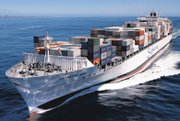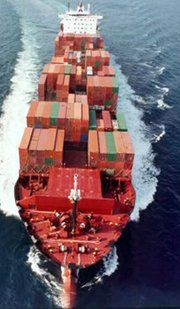Cargo Carriers Pushing Higher Shipping Rates to Stem the Red Ink
For the past year, retailers and apparel importers have had few good-news packages delivered their way.
Retail sales are down, credit terms are tough and consumers are cautious about pulling out their credit cards.
About the only sliver of good news bouncing around recently has been that cargo shipping rates from Asia to the United States have been down about 50 percent from last year. But that could change if shipping companies succeed in boosting rates on eastbound container ships by 57 percent for a 40-foot container.
During the first part of this year, the spot rate to send a 40-foot container on a vessel sailing from China to Los Angeles was as low as $800. Even up until the last week of July, the Hong Kong–Los Angeles container rate was $871 per 40-foot container, or 58 percent lower than one year ago.
But with major shipping lines sinking in a sea of red ink, carriers are attempting to raise rates up $500 per 40-foot container even though retail sales are stuck in negative territory.
“It is clear that, financially, the shipping lines are in a situation where [rates] are not sustainable,” said Paul Bingham, an economist at IHS Global Insight, where he is managing director of world trade and transportation markets. “They can’t continue to incur the losses they have had in the first two quarters of this year and stay in business.”
The shipping industry has been as hard hit as the apparel industry during this economic downturn. During the first quarter of this year, the 14 shipping lines that serve the trans-Pacific route between Asia and the United States saw a 20 percent drop in year-over-year volume. At the beginning of June, 520 cargo container vessels, or 10 percent of the world fleet, were idled, many of them moored off the coast of Singapore.
“The market fell off a cliff,” said Niels Erich, a spokesperson for the Transpacific Stabilization Agreement in Oakland, Calif., whose 14 cargo carrier members make rate recommendations.
With so much capacity early this year, ocean liners started offering bargain-basement rates to shippers during the traditionally slow shipping season. These cheap rates stuck even into contract-negotiation time. Normally, shippers firm up their freight rates in contracts that begin May 1. This year, carriers dragged their feet and didn’t sign contracts until July 1, hedging that spot rates would go up. But they didn’t.
“The fear at the time was that the spot rates were going to turn into contract rates, and many of them did,” Erich said.
When annual contracts were signed and sealed on July 1, many big-box stores locked in a nice deal, saving them millions of dollars in shipping costs.
Then on July 7, the shipping lines scrutinized those contracts and concluded they couldn’t remain afloat if those rates continued. So, on Aug. 10, they announced they would boost the trans-Pacific shipping rate by $500 per 40-foot container. This figure is a “voluntary guideline.” But shippers with contracts aren’t likely to budge until their contract terms expire.
“We don’t think the announced increases will stick,” said Don Lake, vice president of international logistics for Dunavant Enterprises, a major cotton merchant in Memphis, Tenn. The company has a number of shipping contracts in force to send 65 percent of its cotton westbound to Asia. “Given the market and given the fact that we are coming out of a recession and it’s going to be a slow recovery, I don’t see how the market can bear what they are asking for.”
Normally, freight rates on the westbound route to Asia are cheaper than the eastbound side because a good portion of containers loaded onto ships leaving the United States to Asia are empty. The spot rate for cargo containers headed to Asia has only gone up $150 per 40-foot container, Lake said. But logistics make a good portion of Dunavant’s costs.
“If shippers have negotiated contracts with shipping companies at low, fixed rates and with sufficient capacity guarantees, of course there is no reason why they should agree to renegotiate contracts with their vendors at higher shipping rates,” said Philip Damas, division director of Drewry Supply Chain Advisors in London, in an e-mail. “The situation is different if their contract rates are not fixed or expire soon.”
Many contracts are tied to volume. So if shippers use up their volume maximums by, let’s say, February, they will probably be paying the higher price for the rest of their cargo.
The apparel importers and retailers most likely to be hurt will be those who rely on spot rates that vary from day to day.
Supply and demand
While importers grouse about rising shipping costs, no one wants carriers to go out of business, ultimately leading to fewer competitors on the high seas and higher shipping costs. So shipping-industry observers believe there is likely to be some give and take on rates to keep carriers viable.
Carrier finances have gotten pretty precarious. For example, Neptune Orient Lines Ltd., the parent company of APL Limited (American President Lines) in Oakland, Calif., and Southeast Asia’s largest container carrier, has posted three consecutive quarters of losses.
For the first half of this year, ending June 26, the company recorded a $391 million loss, compared with a net profit of $196 million during the same period last year.
Neptune Orient carried 19 percent fewer containers in the quarter, as European and U.S. consumers staunched their spending.
Cargo carriers have been taking drastic measures to cut costs. On top of idling hundreds of ships, executives are taking pay cuts, employees are being laid off and carriers are sharing routes.
Maersk Line has been teaming up with Mediterranean Shipping Co. and CMA-CGM on their trans-Pacific routes. But even that hasn’t been as profitable as expected. So in early August, Maersk announced that at the end of September it would be eliminating one of its trans-Pacific routes, idling a ship that can ferry 8,000 containers from Asia to the United States.
In addition, A.P. Moller-Maersk, the Danish parent company of Maersk Line, said it would close its Odensk Steel Shipyard in Denmark to save money.
“Liners are trying as hard as they can to cut costs and raise rates,” IHS Global Insight’s Bingham said. “They are being driven by financial pressures to be as creative as they can.”























